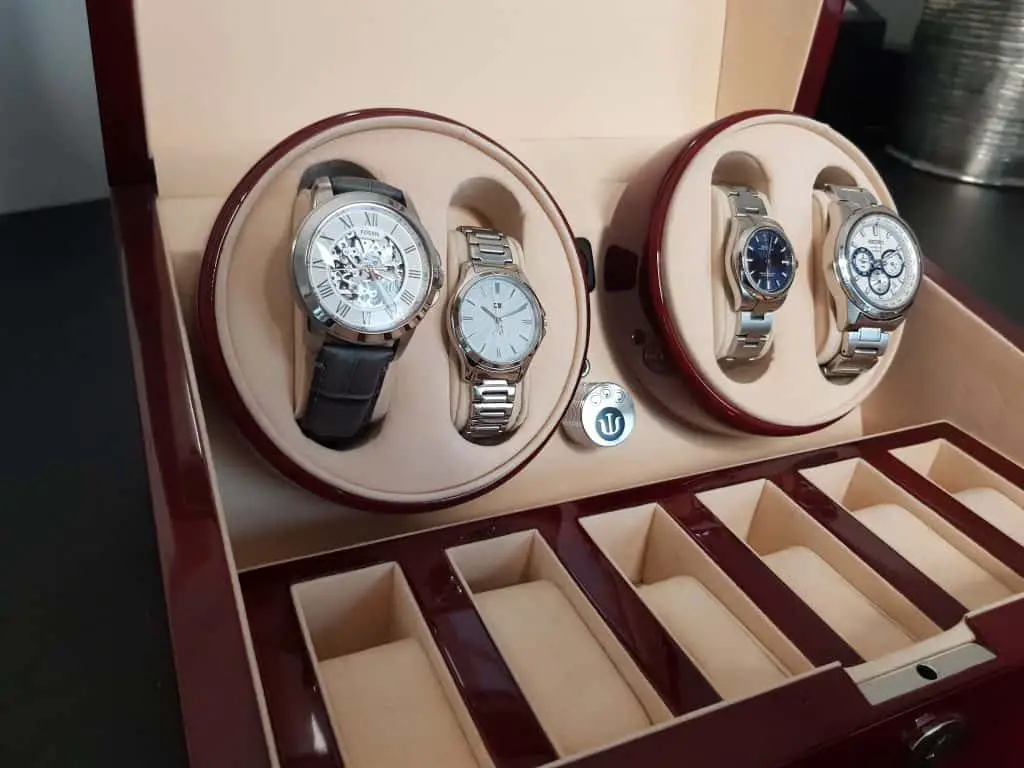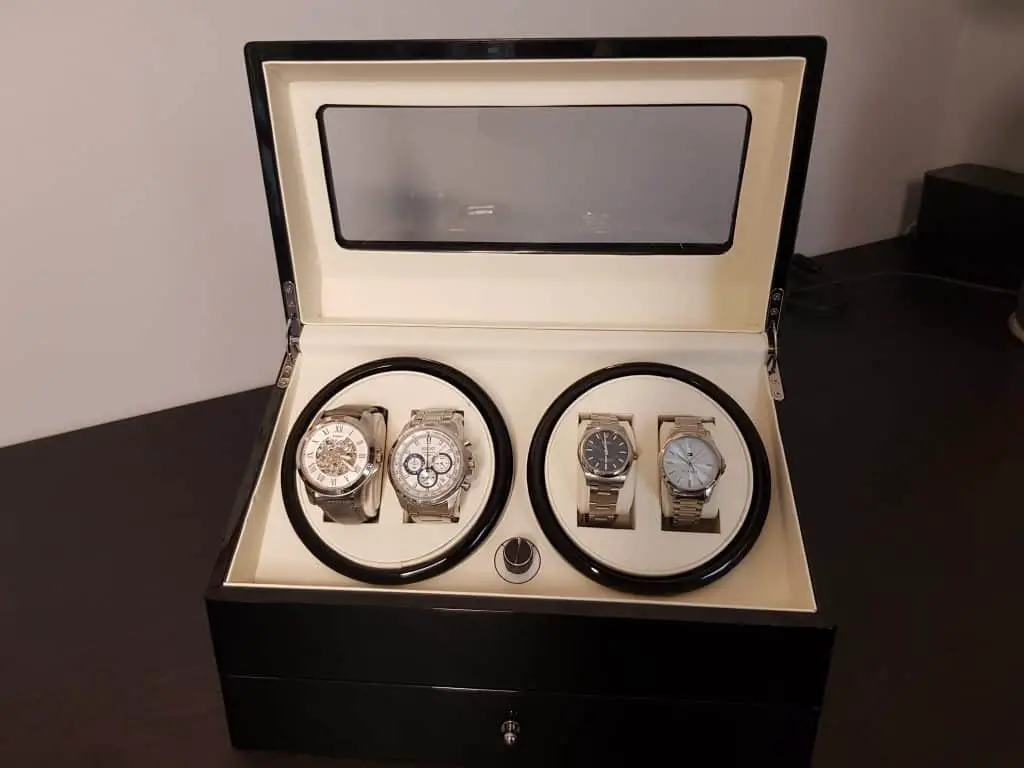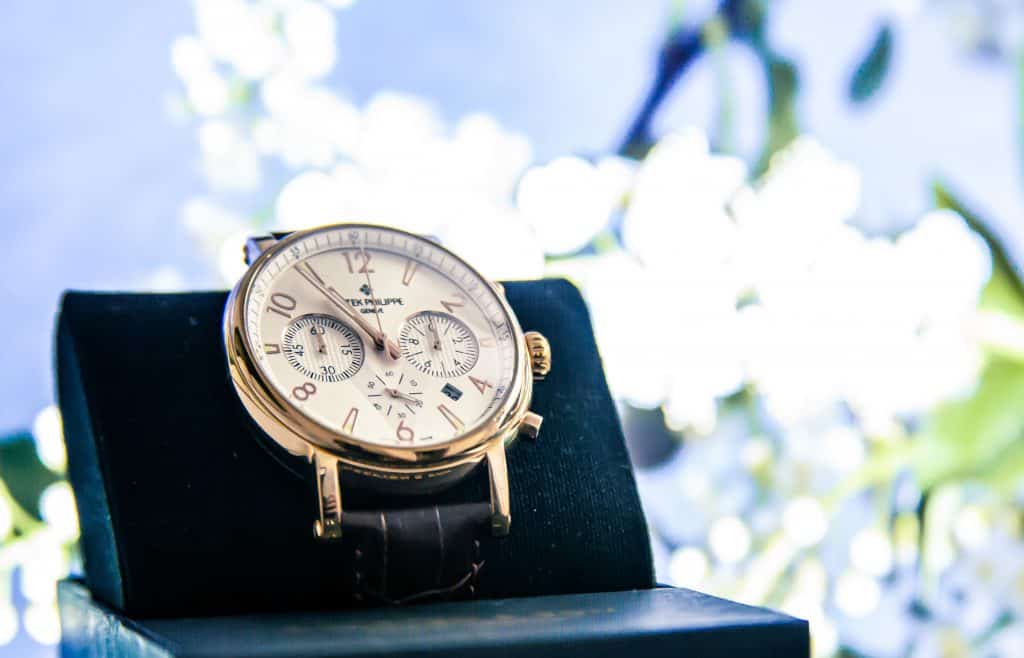As a dedicated watch owner, you want to ensure the best possible conditions for your watch. This is not only valid when you are using it but also when you take it off. One of the most common ways to care for a watch is using a watch winder. Yet, you might have come to wonder, can a watch winder overwind my timepiece?
Quality watch winders should not overwind a timepiece. Quality watch winders have several settings that prevent overwinding and the watch itself has a slip-clutch in place that sets tension free and prevents overwinding.
However, this goes for high-quality watch winders. Not all watch winders will be of high quality and some can actually be damaging to your watch. In this article, we’ll dive a little deeper into overwinding and if it can take place, even in a low-quality watch winder!

Table of Contents
Can A Watch Winder Overwind An Automatic Watch?
A watch winder should not overwind a watch. Automatic watches have a safety mechanism that prevents this from happening. Neither with a watch winder nor manually should a watch be overwound. The mainspring of the timepiece will not be damaged by watch winders.
Automatic watches are designed to be worn 24/7 without suffering any damage. In this sense, there should be no risk in keeping your timepiece in a watch winder. Moreover, this device could offer several benefits.
The safety mechanism of your timepiece is meant to set the tension free when the watch has been wound too much. With this slip-clutch protecting the mainspring, there should not be room for overwinding.
Furthermore, quality watch winders come with a timer and stop-and-go technology. Your watch will not be spinning all the time. Instead, the watch winder will wind your timepiece in intervals to offer even more protection to it.
Even if you wore your watch all day, the slip-clutch mechanism prevents overwinding from happening. If your piece gets overwound, there could be a problem with the safety mechanism.
If the slip-clutch has had to engage regularly for a long time, then there could be damages to this piece. The winder would not cause direct damage, but the safety mechanism could wear out.
With high-end watch winders, this should not be the case. It is crucial to choose a high-quality winder that is compatible with your timepiece. If this is not the case, you risk harming the slip-clutch as well as the mainspring of the watch.
With the proper winder, even the safety mechanism is safe from damages.
To be even more protective of your watch, you should consider the turns per day. Each timepiece has a particular requirement of TPD. With an appropriate watch winder, you can set up the ideal TPD for your watch.
Most winders will wind your watch for 30 seconds to a minute and then rest. The time will depend on the TPD you set.
You should also consider the magnetization of your watch, as some winders could damage it that way. It is essential to know your timepiece to provide the best possible care and conditions.
In general, overwinding an automatic watch is not all that possible. This is a myth that has confused many a watch owner. Don’t be afraid to place your watch inside of a quality winder and let it offer you all its benefits.
How Are Watch Winders Benefical For Your Watch?

A watch winder can emulate the natural movement of the body and keep the watch powered and running. That way, automatic watches can remain wound even when they are not being used. This leads to not having to adjust the time every few days of not wearing it.
Inside this type of watch, there is a rotor that winds the mainspring. This process happens even with the most subtle movement. Because of this, they are also called self-winding watches. The winding of the mainspring powers the rest of the watch through the rotor.
If you use your watch all day, the winding will be done automatically. This type of watch also has a power reserve that stores power from the constant winding. Depending on the model, the reserve can last up to 36-72 hours.
If this is the case for your watch, you can use the timepiece all day, take it off at night, and then use it the next morning without having to reset it.
The winder comes in handy when the watch is not being used. Since the automatic winding is not done by the movement of the body, it can be done by the movement of the winder.
As you can see, watch winders work in concordance with the internal winding mechanism of automatic watches to offer the most benefits.
Why Are Watch Winders Necessary?
Watch winders are necessary to keep automatic watches on time and ready to use. They will also help maintain the day/date settings. For owners with more than one timepiece, keeping the unused one in a winder is the best option. Winders are not necessary for battery-powered watches.
The technology of the watch winders is there to wind automatic watches naturally, recreating the movement of the body. There is nothing forcing the timepiece. This constant winding keeps the piece in its most optimal conditions.
Automatic watches need to be wound to keep their settings accurate. Leaving an unused timepiece out of a winder would result in having to reset the time, day, and date every time you want to wear it.
Watch winders can help here, as your watches will always be ready to use. Moreover, the winder will provide a beautiful box to exhibit your timepiece. At the same time, this device will provide a dust- and moisture-free environment.
The main objective of the winder is to keep the watch as wound as it was when it was placed there. If an unwound watch is placed in a watch winder, it will not be reset nor wound. The winder can only maintain the conditions the timepiece already had.
If the watch is fully unwound, it might need some manual winding to restart. After using the timepiece for some time on your wrist, the rotor should wind the mainspring and power it. You can also give some manual winding to the crown from time to time.
A watch winder is one of the best options on the market for caring for your automatic watch. The watch will always be ready to use, protected from contaminants, and displayed on a beautiful jewelry box.
Why Some Might Think Watch Winders Are Dangerous

The two principal arguments against watch winders are overuse and torque forces. Automatic watches are designed to work 24/7 without problems, so the first argument is not valid. Torque forces can manifest whether in the winder or on the wrist, making this one a weak argument.
If you think about overuse as a reason not to use watch winders, you shouldn’t ever consider using your watch on a regular basis. Unlike what you might think, manufacturers design their pieces with overuse in mind.
Some watch owners refuse to leave their watches at home, regardless of the occasion. If watches can be used all the time, then they can also be left in watch winders without problems. Moreover, the constant winding will keep all the parts oiled and working in perfect conditions.
The winder will prevent clogging and will keep all the pieces lubricated. The watch will run smoothly when you put it on again.
Regarding the second argument, almost any vivid movement could cause torque force. There is no reason to believe that this could happen in the winder and not when you are wearing the watch.
The fast movements of anybody who has a demanding job will be harsher than the constant and controlled movements of a winder. In this sense, a watch winder would create less torque force than an active person.
Once we have taken these two arguments and overwinding out of the picture, we see that watch winders are not dangerous. Of course, there are some risks attached to using low-quality ones. Selecting the proper winder will be paramount for protecting your watch.
One of the problems a low-quality watch winder could cause is magnetization. Due to the technology in the winders, the electric motor and the magnets could create a magnetic field that could affect the functionality of the timepiece.
Nevertheless, this should not be the case with a quality and compatible watch winder. Choose the correct winder to suit the needs of your watch, and you will be out of danger on all fronts.
To know more about watch winders, check this informative article I wrote about them.
